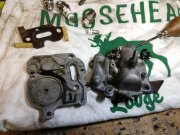Hey every one! First post on this forum, stumbled upon the site looking for some insight on how to tune the Mac bullfrog carb.
Inherited this McCulloch Mac 110 from a friend of mine who passed away. She sat for about 10 to 15 years in storage. We had tried years ago to get her running only to find out the parts are hard to find. So this mission is being set fourth in his honor.
I recently disassembled the whole thing and cleaned her up and took apart the carburetor. Diaphragm was stiff and rigid I found a new one on eBay for about 25 bucks shipping included. Reinstalled it, put it all back together. She will turn over and run a little bit, (some times full RPMs then kaput) but I'm not sure how to set the high, low and idle screws. Also she leaks a little bit of fuel from the primer side and the fuel metering needle.
I acquired the shop manual (scanned pdf), but some of the pictures are hard to make out. It looks like the single needle version.
Wondering if this was an adjustment that can be done, or if I need to get new O-rings for the primer. I also saw that there is a duckbill check valve that commonly clogs up. Any help suggestions, Insight on tuning this carb would be greatly appreciated. I would love to get this puppy running to go cut down some wood 4 a bonfire down by the river!
Thanks in advance for any advice!!
Jay
Inherited this McCulloch Mac 110 from a friend of mine who passed away. She sat for about 10 to 15 years in storage. We had tried years ago to get her running only to find out the parts are hard to find. So this mission is being set fourth in his honor.
I recently disassembled the whole thing and cleaned her up and took apart the carburetor. Diaphragm was stiff and rigid I found a new one on eBay for about 25 bucks shipping included. Reinstalled it, put it all back together. She will turn over and run a little bit, (some times full RPMs then kaput) but I'm not sure how to set the high, low and idle screws. Also she leaks a little bit of fuel from the primer side and the fuel metering needle.
I acquired the shop manual (scanned pdf), but some of the pictures are hard to make out. It looks like the single needle version.
Wondering if this was an adjustment that can be done, or if I need to get new O-rings for the primer. I also saw that there is a duckbill check valve that commonly clogs up. Any help suggestions, Insight on tuning this carb would be greatly appreciated. I would love to get this puppy running to go cut down some wood 4 a bonfire down by the river!
Thanks in advance for any advice!!
Jay


















